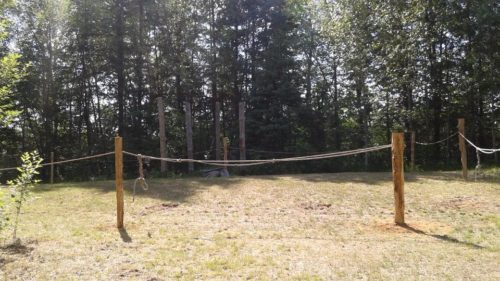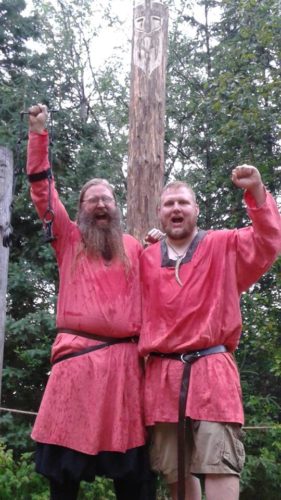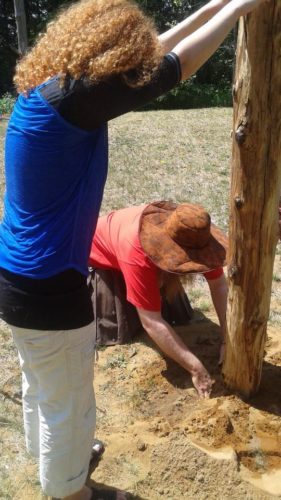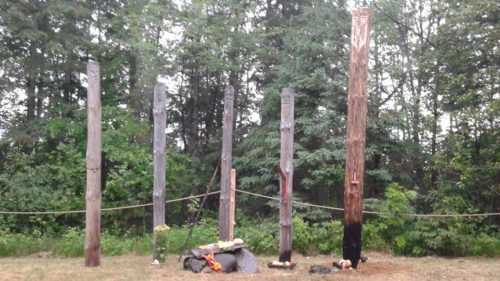EGANVILLE, Ont. – Canada’s only public place of worship dedicated to honouring the pre-Christian Scandinavian and Germanic gods, has just been rebuilt and enlarged to accommodate growing numbers of visitors. Known as a Vé, this open-air holy site is located in a grove-like clearing amid a mixed forest of deciduous and coniferous trees. It consists of nine posts in a squared formation with a portico at its lowest point. The entrance faces high ground where god-poles, dedicated to Freyja, Frigg, Odin, Freyr and most recently, Thor are located. A low, natural stone altar is set in front of the god-poles. The area is enclosed by the Vé-bond rope, which is ritually hung from the posts. The land is part of Raven’s Knoll, a 100-acre Pagan-owned and -operated campground near Eganville, Ontario, along the Bonnechere River.

The Ve at Raven’s Knoll [Photo Courtesy Erik Lacharity]
The perpetrator of this vandalism is believed to be a young and gangly moose who had been hanging around the property at the time. The damage provided opportunity to make the Vé larger, as the numbers of folk attending rituals and ceremonies at the site are growing. The Vé was getting stretched to capacity.
Raven’s Knoll steward and gothi Austin Lawrence is the primary caretaker of the Vé. In a recent interview with The Wild Hunt, he explained how the Vé is used, and who uses it. Lawrence said:
The Vé was created for the worship of gods and goddesses of the pre-Christian religious traditions of the Old Norse and Germanic peoples. In particular, the Vé is a powerful and sacred place to interact with their power directly and intimately. This is done in large group rituals, such as blóts at the Hail and Horn Gathering, or through individual worship throughout the Spring, Summer and Fall when the campground is open. Some people spend time in the Vé to meditate, to read omens, to do personal rituals such as dedications or to speak marriage vows.
The Vé is open to anyone that makes the oath required to enter the Vé and follows the rules and taboos of that oath. To enter and participate in any ritual taking place in the Raven’s Knoll Vé, three basic rules should be strictly followed as a sign of respect for the holy powers and to ensure one’s own continued good fortune. These rules are to: 1) honour only the Æsir and their close allies; 2) keep frith and maintain good relations; and, 3) maintain sacral cleanliness, keeping the Vé holy and undefiled.
Most people prefer to make that oath to a gothi or gythia or other ring-bearer who has done ritual in that place at the Hail and Horn Gathering. However, anyone who has previously been oathed into the Vé can administer the oath. It does not matter, one bit, what biological ancestry, sexual or gender identity, class background, nationality, creed or other similar factor someone has. Anyone can enter the Vé, so long as they follow the rules and taboos.

Lawrence and Lacharity celebrate the newest god-pole. (courtesy of E.Lacharity)
Lawrence went on to explain where the original inspiration came from to create the Vé. He said:
We were originally inspired to create the Vé at Raven’s Knoll after reading the “risala” of Ibn Fadlan, ambassador of the Caliph of Bagdad to the King of the Bulgars, from the year 921 C.E. This account is one of the few first person accounts of how Heathen Scandinavians practiced their religion.
As modern Heathens with a passion for reconstructing the religions tradition of our ancestors, our goal is to create an accessible, publicly accessible place to worship the Aesir in the manner of the ancients. We have found that this allows for some of the most intense and close spiritual experiences possible in the various Heathen religious traditions. We simply want to share our love and experience of the gods with others.
One of the many co-creators of this sacred space is Erik Lacharity. He shared how it feels to be a part of constructing such a special place. He said, “It means that I am inextricably tied to the place. My deeds, my words are bound as much to the Vé as are the poles that stand within it. When I think back to the efforts I have exerted there, I feel that I have lived. I cannot imagine having gone through life and not been involved in the development and establishment of such a grand holy site.”
Lacharity explained how the Vé, as well as Raven’s Knoll and its growing community have all taken on a special role in his life:
As a person, I chose to live my life mythically. That is, I immerse large segments of my reality into what I perceive as a cosmic tapestry that is influenced by, at once my own deeds and the whims of the gods and ancestors. Raven’s Knoll gives me a place that I can live such a mythic life among others who value the experiences shared there to a similar degree. In such a small place in a rural town in Ontario of all places, I can strive to become as the “big men” who came before me and leave a lasting impression on those yet to come. It is here that I, and many others can be “all that we can be”.
Rebuilding the Vé and acquiring the resources needed was a large project, involving many of the folk from the local area. New posts needed to be sourced. The original red pine ones, which came from the surrounding forest, rotted quickly.
Local Heathen farmers, Kristoff Loki Wodinson and his partner Yitka Wodinson were able to donate new, more durable, cedar posts to the project. The ritual elements necessary for setting the posts were contributed by Lacharity, Lawrence and Juniper Jeni Birch. The hard physical labour of setting up the space, was shared by many hands.
Gypsy Birch, one of these workers, described the process:

Lawrence and Juniper Jeni Birch ritually set a pole [Photo Courtesy E.Lacharity]
For the past couple months, I have taken over the general maintenance of the Vé in terms of cutting the grass, the pushing back of overgrowth, and general upkeep. Many people seem to forget how much work goes into maintaining a sacred space, and part of my personal path is to allow people of other faiths to focus on their personal spirituality without worrying about the details. The act of repairing the two broken posts and the subsequent expansion of the Vé space is not something that was done in a day. There was much coordination required in order to clear the undergrowth, accurately measure the new space, source the new posts, cut and transport the new posts, remove the old posts, fill in the old holes, dig the new holes, and place the new poles.
This does not even take into account the ritual requirements of many of these tasks. James and I worked hard to coordinate a lot of these behind-the-scenes tasks, but admittedly, his work at getting the posts measured, cut, and delivered from Loki and Yitka’s farm, and then sitting in the sun for hours to skin the posts of their bark was by far the most labour-intensive part of the process. Of all the work that was done and the hours of sweat put into building the physical space, my personal spiritual growth comes from knowing that I have helped remove the burden of labour from others.
Last weekend, during Hail and Horn Gathering (HHG), a new god-pole was created and erected as the main ritual. Each year at this event, a Norse god is highlighted, and a god-pole dedicated to them and added to the Vé. Next year’s HHG will be held June 30 through July 3, and will feature two deities: Heimdall and Syn.

The god-poles (L to R): Freya, Frigg, Odin, Freyr and Thor. (courtesy of Erik Lacharity)
The Wild Hunt is not responsible for links to external content.
To join a conversation on this post:
Visit our The Wild Hunt subreddit! Point your favorite browser to https://www.reddit.com/r/The_Wild_Hunt_News/, then click “JOIN”. Make sure to click the bell, too, to be notified of new articles posted to our subreddit.

honour only the Æsir and their close alliesWhat’s the status of Loki followers at Ve? I’m curious because one of the principals has that middle name.
Loki followers are absolutely welcome, and His name is not banned from being spoken. However, to keep frith with those who are less comfortable with Loki, and to ensure that He receives His own proper and respectful worship, a second Ve stands at the Knoll. The Jotun Ve is at the other end of the shrine trail, it is more wild and organic than the Ve featured in this article. Within the Jotun Ve you will find Loki, Hel, and others.
Thank you for taking time to reply.
“The perpetrator of this vandalism is believed to be a young and gangly moose..”
So where is squirrel???? (sorry, just had to do that!)
During the winter I took many trips into the Ve by snow shoe and discovered the first pole damaged about mid winter. The Ve is frequented by many animals, but most noted are Deer. It is an Ideal spot for them to bed down at night and it is sleeping quarters for the 7 or so that make the Ve thier nightly winter refuge.
The Shrine trail created by Gypsy leads to the Ve originally (and still is) a deer trail that has been expanded to accommodate Humans and designed to be wheel chair accessible. It incorporates a few small bridges and a seating area midway through in case you want to sit in the middle of the forest and take a rest.